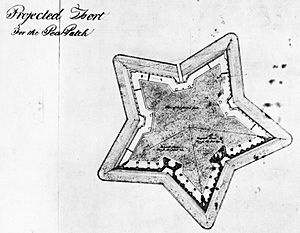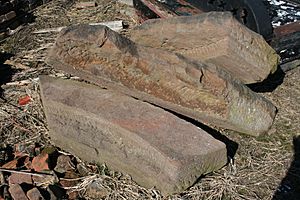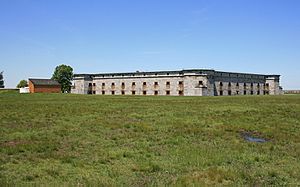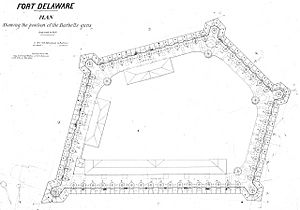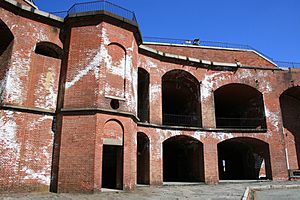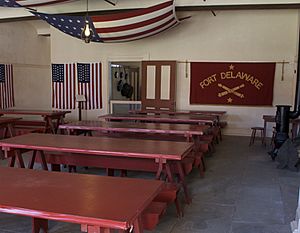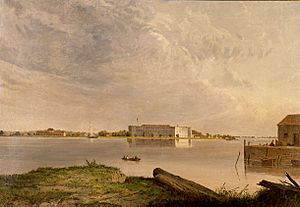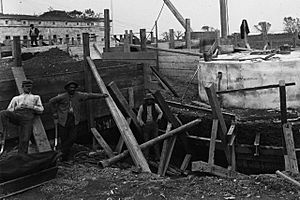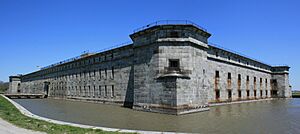Fort Delaware facts for kids
Quick facts for kids Fort Delaware |
|
|---|---|
| Part of American Civil War prison camps 1861–1865 Harbor Defenses of the Delaware 1898–1945 | |
| Fort Delaware, Pea Patch Island, New Castle County, Delaware, United States | |

Fort Delaware during the American Civil War
|
|
| Lua error in Module:Location_map at line 420: attempt to index field 'wikibase' (a nil value). | |
| Type | Garrison Fort, Training Camp, Union Prison Camp |
| Site information | |
| Owner | U.S. Government |
| Controlled by | Union Army |
| Open to the public |
Yes |
|
Fort Delaware
|
|
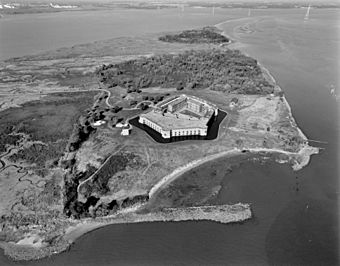
Fort Delaware on Pea Patch Island
|
|
| Location | Fort Delaware State Park, Pea Patch Island, New Castle County, Delaware, USA |
| Nearest city | Delaware City, Delaware |
| Area | 288 acres |
| Built | 1846-1868 |
| Architect | Joseph G. Totten |
| Architectural style | Third System |
| NRHP reference No. | 71000226 |
| Added to NRHP | December 16, 1971 |
| Site history | |
| In use | 1846–1945 |
| Battles/wars | American Civil War World War I World War II |
| Garrison information | |
| Occupants | U.S. Army soldiers, Confederate prisoners of war |
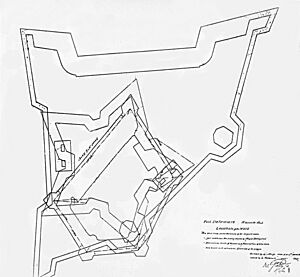
Fort Delaware is an old fort on Pea Patch Island in the Delaware River. It was built to protect the harbor. During the American Civil War (1861-1865), the Union Army used Fort Delaware as a prison. It held Confederate soldiers, political prisoners, and other people.
Later, in the 1890s, new big guns were added inside the fort. By 1900, Fort Delaware worked with two other forts, Fort Mott and Fort DuPont, to defend the Delaware River. Today, the fort and island are part of Fort Delaware State Park. It is a living history museum where you can learn about the past.
Contents
- Discovering Fort Delaware's History
- The First Star-Shaped Fort
- A Bigger Fort Design That Wasn't Built
- The Current Fort Delaware: A Pentagon Shape
- Fort Delaware During the Civil War
- Fort Delaware After the Civil War
- Modernizing Fort Delaware for New Wars
- Fort Delaware in World War I and II
- Fort Delaware Today
- See also
- Galleries
Discovering Fort Delaware's History
In 1794, a French engineer named Pierre Charles L’Enfant thought Pea Patch Island was a great spot for defense. At first, a doctor owned the island and used it for hunting. The US Army wanted to buy it, but he refused.
The state of Delaware then said it owned the island. In 1813, Delaware gave the island to the U.S. government. This led to a legal fight over who truly owned Pea Patch Island. In 1820, it was decided that Delaware had the right claim.
Early Fortification Efforts
During the War of 1812, people tried to build defenses on Pea Patch Island. They built a seawall and dykes around the island. There isn't much proof that a fort was finished during this war. The first idea was to build a Martello tower.
The First Star-Shaped Fort
Construction of a star fort began on Pea Patch Island around 1817. This fort was meant to protect important cities like Philadelphia. It would also cover the Chesapeake & Delaware Canal.
Building Challenges and Problems
The star fort was designed by engineer Joseph G. Totten. Building it was hard because the island was marshy and soft. There were problems with the foundation, and parts of the fort cracked. An entire section of 43,000 bricks had to be rebuilt!
In 1824, the supervisor, Captain Samuel Babcock, faced a military trial. He was found not guilty of neglect, but made errors in judgment.
Early Commanders and Soldiers
Major Alexander C.W. Fanning was the first known commander of Fort Delaware before 1825. Soldiers from the 2nd U.S. Artillery were stationed there. Later, Major Benjamin Kendrick Pierce commanded the fort. He was the older brother of Franklin Pierce, who became the 14th U.S. President.
The Great Fire of 1831
In February 1831, a fire started in an officer's room and destroyed much of the fort. The soldiers had to move to a federal arsenal nearby. The damaged fort was torn down in 1833. Its rubble was used to strengthen the island's seawall. You can still see some of the sandstone pieces today.
A Bigger Fort Design That Wasn't Built
After the fire, Captain Richard Delafield designed a much larger, polygonal fort. It was meant to be a "marvel of military architecture." However, a long legal fight over the island's ownership stopped construction. The dispute lasted ten years. In 1848, it was finally decided that the U.S. government had a valid claim to the island. No more work was done on Delafield's grand design.
The Current Fort Delaware: A Pentagon Shape
The Fort Delaware you see today was built mostly between 1848 and 1860. It was one of the largest forts in the "third system" of U.S. coastal defenses. The fort is shaped like an uneven pentagon, with five small towers at its corners. It had three levels for cannons to protect the river. The back wall had many small openings for muskets and more cannons on the roof. A moat surrounded the fort, with a gate to control its water level.
Building a Strong Foundation
Building on Pea Patch Island was tough because the ground was soft mud, sometimes 40 feet deep. Workers used steam-powered pile drivers to push long wooden poles deep into the ground. This created a strong base for the fort. They drove over 4,900 piles!
Stone and Brick Work
The fort is made of gneiss, granite, brick, and cement. Gneiss stone was first used, but it was too hard to shape. Later, granite from Pennsylvania was used for walls and stairs. Millions of bricks from Wilmington and Philadelphia were used for the fort's inside walls, barracks, and storage rooms. Arches and vaults helped distribute the weight and make the fort stable.
Ready for War
In 1859, engineers reported the fort would be ready by 1860. In 1861, before the American Civil War began, Captain Augustus A. Gibson took command with a small group of 20 soldiers. Their main job was to install cannons. By 1866, about 156 cannons filled the fort's gun positions.
Fort Delaware During the Civil War
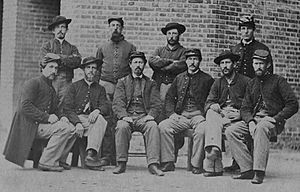
During the Civil War, Fort Delaware became a prison camp. It held captured Confederate soldiers, Union soldiers who broke rules, and some local political prisoners. The first prisoners stayed inside the fort in sealed-off rooms. You can still see names carved into the bricks by these prisoners.
Barracks and Hospital for Prisoners
In 1862 and 1863, wooden barracks were built outside the fort for enlisted prisoners. This area was called the "bull pen." Many Confederates captured at the Battle of Gettysburg were sent here. A large hospital with 600 beds was also built.
One prisoner, Pvt. Henry Robinson Berkeley, described the barracks as "common wooden sheds." Another, Lt. Francis W. Dawson, said they could hold about ten thousand people.
Prisoner Health and Deaths
By August 1863, over 11,000 prisoners were on the island. By the end of the war, nearly 33,000 men had been held there. About 2,500 prisoners died on Pea Patch Island. This was about 7.6% of all prisoners. Half of these deaths happened during a smallpox outbreak in 1863. Other common causes of death were lung problems and different types of diarrhea. Many who died are buried at Finn's Point National Cemetery in New Jersey.
Food and Living Conditions (Outside the Fort)
Enlisted prisoners and junior officers lived in the wooden barracks outside the fort. In 1864, food rations were cut. This was in response to how Union soldiers were treated in Southern prison camps. Prisoners still could buy extra food and fish in the river. They also received more care packages than prisoners in other camps.
Pvt. Henry Berkeley noted, "We only get two light meals a day." Capt. Robert E. Park described the food as "a slice of baker's bread, very often stale, with weak coffee, for breakfast." Drinking water was brought from a creek about ten miles away.
Food and Living Conditions (Inside the Fort)
High-ranking Confederate officers and some political prisoners stayed inside the fort. They lived in former laundry rooms and open barracks. These prisoners often had more freedom and access to better food.
Reverend Isaac W. K. Handy, a political prisoner, wrote in 1864 that their supplies were "abundant." They had hams, turkeys, jellies, and other good foods. He noted, "The only article regularly furnished by the Government commissary is bread."
The "Immortal 600"
On August 20, 1864, six hundred Confederate officers left Fort Delaware on a ship. They were sent to Morris Island in South Carolina. This was a response to Union officers being held in Charleston. This group of prisoners became known as the "Immortal Six Hundred".
Soldiers Guarding the Fort
Many different volunteer troops guarded Fort Delaware during the war. These included soldiers from Pennsylvania, New York, Delaware, Maryland, Massachusetts, and Ohio. They manned guard posts inside the fort and along the seawall around the island.
Fort Delaware After the Civil War
After the Civil War, a small group of soldiers from the 4th U.S. Artillery stayed at the fort. In the 1870s, there were plans to add larger cannons.
Storms and Damage
In October 1878, a huge hurricane hit the area. It damaged many buildings outside the fort. The Trinity Chapel, built by Confederate prisoners, was partly destroyed. In August 1885, a tornado struck the island, destroying the hospital and other structures.
Modernizing Fort Delaware for New Wars
Before the Spanish–American War in 1898, a special building was constructed to control underwater mines. These mines could be placed in the Delaware River to protect against enemy ships.
New Gun Batteries
In the late 1890s, new gun batteries were built at Fort Delaware. These were part of a plan to modernize coastal defenses. The new batteries were spread out and hidden behind concrete walls. Fort Delaware worked with Fort DuPont and Fort Mott as the first forts of the Coast Defenses of the Delaware.
A large, three-story concrete battery, called Battery Torbert, was built inside the fort. It held three huge 12-inch guns that could shoot about 10 miles. Smaller, faster-firing guns were also added to protect the island and the minefield. These were named Battery Allen and Battery Alburtis. Other batteries, Battery Dodd and Battery Hentig, were built outside the fort.
Soldiers During the Spanish-American War
During the Spanish-American War, soldiers from the 4th U.S. Artillery and volunteers from Pennsylvania guarded the fort. You can still see their names carved into the brick walls inside the fort.
Fort Delaware in World War I and II
During World War I, Fort Delaware was a smaller outpost to Fort DuPont. In 1919, soldiers began to close down the old fort, removing most items. Some old cannons were even buried on the island.
In World War II, Fort Delaware lost its big 12-inch guns. They were sent to other forts. The island was guarded by soldiers from the Delaware Army National Guard. They used two rapid-fire guns from Battery Hentig. These guns were also moved in 1942, leaving Fort Delaware unarmed. After the war, the fort was no longer needed by the military.
Fort Delaware Today
Delaware bought the fort from the U.S. government in 1947. Today, Fort Delaware State Park covers all of Pea Patch Island. You can take a ferry from Delaware City or Fort Mott to visit. Once on the island, a small vehicle takes visitors to the fort.
You can take tours and see special programs. For example, an 8-inch Columbiad gun is fired daily. Park staff and volunteers dress up and show what life was like during the Civil War.
Protecting the Island
In 1999, people realized that the island's beaches were eroding. The United States Army Corps of Engineers built a long seawall in 2005-2006. This wall protects the historic fort and a large migratory bird rookery. This bird habitat is the biggest north of Florida.
Fun Events at the Fort
Since 2009, Fort Delaware has hosted games by the Diamond State Base Ball Club. This team plays vintage base ball, which is baseball played by old rules. They also play at nearby Fort DuPont.
Fort Delaware on TV
The fort has been featured on several TV shows. The Sci-Fi Channel series Ghost Hunters investigated the fort twice, including a live show in 2008. Ghost Hunters Academy also filmed an episode there. The British series Most Haunted also visited the fort.
See also
- Seacoast defense in the United States
- Harbor Defense Command
- United States Army Coast Artillery Corps
- List of coastal fortifications of the United States
Galleries
Buildings and Grounds
Interiors
Other


